February 22nd - March 3rd, 1998
 When you are looking at a map of Texas, one might imagine that
Corpus Christi is about as far east as you can go, but there is
actually a thin strip of sand, about a mile wide and about a hundred
miles long stretching down the coast. About 20 miles of this sand
at the north end is Mustang Island. The rest is Parde Island.
Having visiting many of the metropolitan cities in the south, I felt it was
time for a less cluttered week.
When you are looking at a map of Texas, one might imagine that
Corpus Christi is about as far east as you can go, but there is
actually a thin strip of sand, about a mile wide and about a hundred
miles long stretching down the coast. About 20 miles of this sand
at the north end is Mustang Island. The rest is Parde Island.
Having visiting many of the metropolitan cities in the south, I felt it was
time for a less cluttered week.
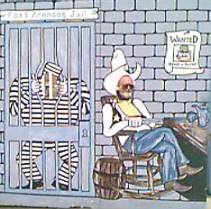 Something with sun and ocean and
relaxation, where I could catch up on some of my writings and just
take it easy. Port Aransas at the north tip was the place.
It was first named Port Sand in 1833, then Port Aranzazu. Mustang Island was
finally fortified during the Mexican War of 1846. These fortifications
lasted until well after the Civil War. It continued to build as a shipping
port and entrance to Aransas Bay.
Something with sun and ocean and
relaxation, where I could catch up on some of my writings and just
take it easy. Port Aransas at the north tip was the place.
It was first named Port Sand in 1833, then Port Aranzazu. Mustang Island was
finally fortified during the Mexican War of 1846. These fortifications
lasted until well after the Civil War. It continued to build as a shipping
port and entrance to Aransas Bay.
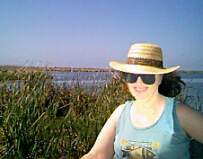 The Island was completely wiped out in
a storm in 1875. It was rebuilt as Ropesville in 1890 and then changed it
name to Tarpon because of the large numbers of the fish being caught in the
surrounding waters. It had a population of 250 when the citizens began calling
their town Port Aransas around 1910. In 1919 the great storm that wiped out
Galveston (see our web-page) leveled all building on this island save three.
Port Aransas is now a tourist and fishing village
The Island was completely wiped out in
a storm in 1875. It was rebuilt as Ropesville in 1890 and then changed it
name to Tarpon because of the large numbers of the fish being caught in the
surrounding waters. It had a population of 250 when the citizens began calling
their town Port Aransas around 1910. In 1919 the great storm that wiped out
Galveston (see our web-page) leveled all building on this island save three.
Port Aransas is now a tourist and fishing village
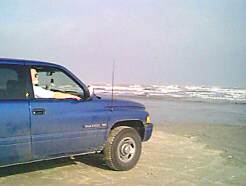 A few shops and restaurants,
one road straight down the middle of the island and for the alternate route,
you can drive on the beach. The widest part of Mustang Island is the very
north end at Port Aransas. This area is marsh and brackish water in the middle
surrounded by sand dunes and the Gulf
A few shops and restaurants,
one road straight down the middle of the island and for the alternate route,
you can drive on the beach. The widest part of Mustang Island is the very
north end at Port Aransas. This area is marsh and brackish water in the middle
surrounded by sand dunes and the Gulf
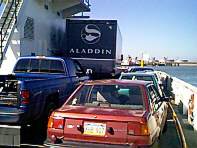 Getting there with a 5th wheel can be an adventure. The direct route is on US
361 to state route 22. The interesting part is that the road doesn't go all the
way. A 1/4 mile of it is missing and a ferry is required to complete the trip.
Port Aransas is one of the most noted areas for bird watching, boasting of
hundred of species both native and migrating.
One of Port Aransas’ most enduring quality is that it is the winter home of the almost
extinct whooping crane. Once numbering only a total of 15 birds in the early 1900eds, they are now
undergoing one of the most extensive breeding programs designed. The last week of February
is set aside to honor the bird with the Birding Festival. A week of bird watching, trips to see
the recently arriving whooping cranes who have flown down from northern Canada in about 20
days.
Getting there with a 5th wheel can be an adventure. The direct route is on US
361 to state route 22. The interesting part is that the road doesn't go all the
way. A 1/4 mile of it is missing and a ferry is required to complete the trip.
Port Aransas is one of the most noted areas for bird watching, boasting of
hundred of species both native and migrating.
One of Port Aransas’ most enduring quality is that it is the winter home of the almost
extinct whooping crane. Once numbering only a total of 15 birds in the early 1900eds, they are now
undergoing one of the most extensive breeding programs designed. The last week of February
is set aside to honor the bird with the Birding Festival. A week of bird watching, trips to see
the recently arriving whooping cranes who have flown down from northern Canada in about 20
days.
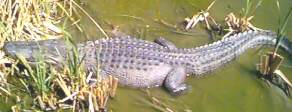 We walked out onto a board walk
into the center marshes to see egrets, pelicans and cranes. There were easily
over 50 varieties of water fowl within a stones throw of us. All under the
watchful eye of the resident alligators who were apparently oblivious to
their human observers. One of the ‘gators was called “Boots” the other “Belts”. Hmmmmm.
We walked out onto a board walk
into the center marshes to see egrets, pelicans and cranes. There were easily
over 50 varieties of water fowl within a stones throw of us. All under the
watchful eye of the resident alligators who were apparently oblivious to
their human observers. One of the ‘gators was called “Boots” the other “Belts”. Hmmmmm.
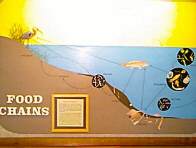 We visited the University of Texas’ Marine Science Institute. A training and research
facility in Port Aransas. This institute conducts research throughout the year in disciplines
including ecology, physiology, microbiology, marine chemistry, organic geochemistry and
many other areas. There is a theater in which we watched a National Geographic presentation
of the flight of the whooping crane from Port Aransas to Canada. Around the theater were many
aquariums representing the ecosystem of the Gulf. A second building houses many educational
displays that relate to the surrounding area.
We visited the University of Texas’ Marine Science Institute. A training and research
facility in Port Aransas. This institute conducts research throughout the year in disciplines
including ecology, physiology, microbiology, marine chemistry, organic geochemistry and
many other areas. There is a theater in which we watched a National Geographic presentation
of the flight of the whooping crane from Port Aransas to Canada. Around the theater were many
aquariums representing the ecosystem of the Gulf. A second building houses many educational
displays that relate to the surrounding area.
